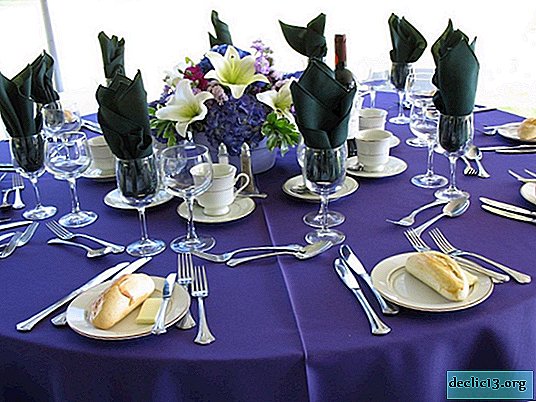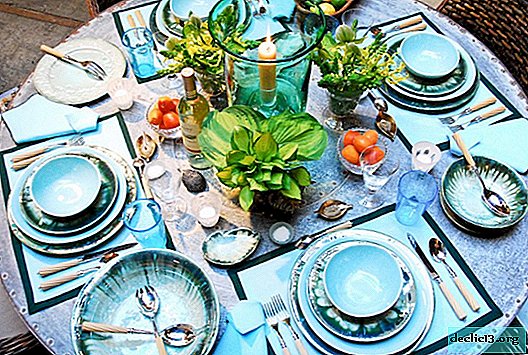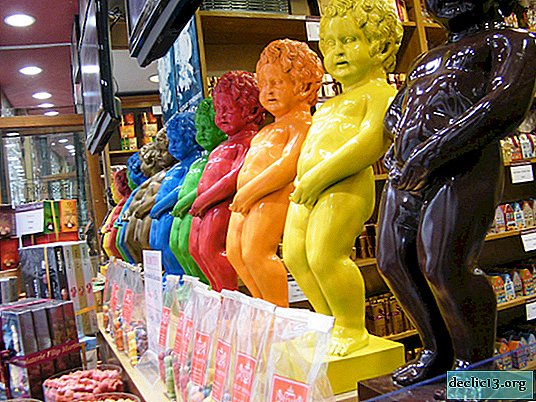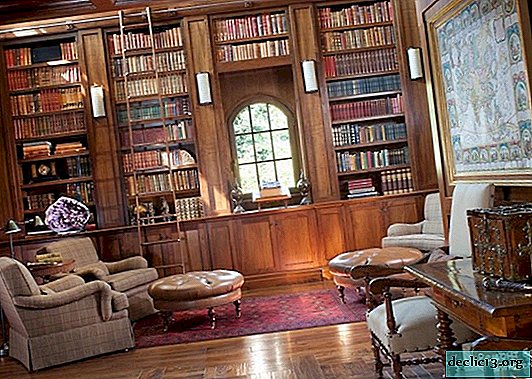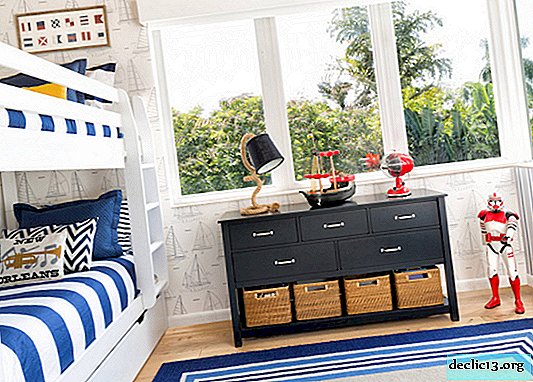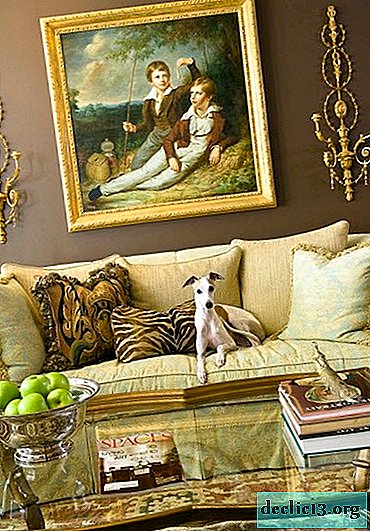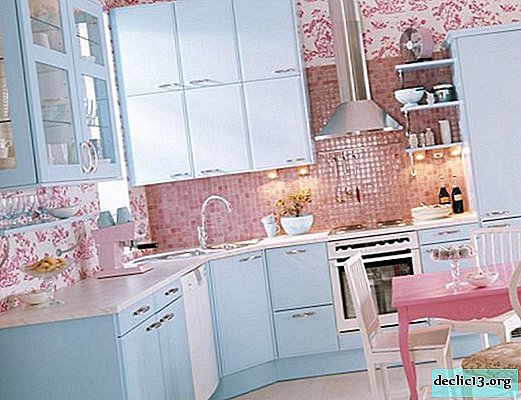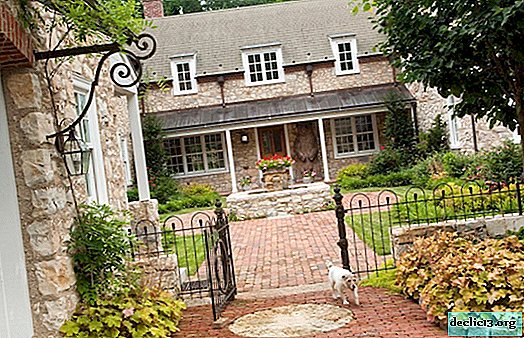The rules of table setting for etiquette, the choice of dishes and decor
A joint family meal, especially for a solemn occasion, is surrounded by a number of rules and traditions. An important place among them is table setting - this is a kind of ritual designed to create the appropriate mood for guests, fill the room with the spirit of fun, celebration. There are no and cannot be trifles. Everything is important: the choice and size of the tablecloth, the arrangement of plates, cutlery, glasses, the presence of decor.
Rules and sequence of etiquette serving
The term "serving" comes from the French word service. But this is not just about a laid table with food. Under this expression we understand a whole sequence of interconnected actions:
- table setting - spread a tablecloth, lay out cutlery, decorations;
- serving dishes - decorate food before serving;
- serving wine - select and serve drinks that are suitable for each dish.
Depending on the time of meal, there are:
- separate servings for breakfast and lunch;
- evening option (dinner, reception, banquet).
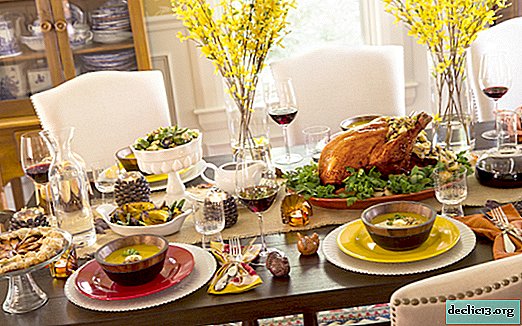
Festive or solemn serving involves the following ways of serving dishes:
- Russian. In this embodiment, the food is distributed in advance in separate portions in the kitchen or buffet. Serving is sequential - each dish appears on the table in due time.
- English. The waiter goes around all the guests and offers them a meal. Also, his work includes laying portions on plates.
- French. This option allows more freedom. All dishes are placed on the table immediately, guests take their favorite treats on their own. No need to wait for a waiter or serve another meal. You can not be limited to one serving, take quite a bit of one or another goodies or even completely abandon it.
All options begin with the most important thing - a table covered with a tablecloth. Then plates, glasses, cutlery and sets for spices are placed on it, and napkins are laid out. The final touch is decoration. Depending on the theme of the event, the table is decorated with fresh flowers, candles, accessories suitable for the occasion (Christmas fir branches, Easter baskets with eggs, wedding miniatures and other decor).
 Russian way of serving dishes
Russian way of serving dishes English
English French
FrenchHow to make a tablecloth
Textiles on the table set the tone for the entire serving. A tablecloth as a background can emphasize the solemnity of the moment, or vice versa, spoil the mood. Therefore, it must be spotlessly clean, whole and without scuffs. It is checked in advance, washed and ironed.
To cover a table with oilcloth, even completely transparent, is a bad tone. If there is concern that the tablecloth may get dirty, place a cloth napkin, plastic or wicker mats under each plate. But this is not the best option for special occasions.
According to the general rules of table setting, the tablecloth is chosen in accordance with the occasion of the celebration:
- The official reception requires white Kamchatka. So called linen or cotton tablecloth, woven with shiny convex patterns. You can replace it with a smooth linen or linen, but Kamchatka looks more solemn. A soft lining is placed under the main tablecloth so that cutlery and plates do not knock during serving and during the meal. For this purpose, use felt or felt, cut to the size of the countertop. For table setting at home, you can use a sheet folded several times.
- A gala dinner in an old mansion or room designed in the style of a "noble's nest" can be decorated with a lace or tablecloth decorated with embroidery. However, do not choose bright and lush patterns.
- For quiet family celebrations and serving a festive table at home, light elegant, and sometimes bright embroideries are more suitable. In this case, it is necessary to ensure that the pattern is located strictly symmetrically relative to the contours of the table.
- Modern etiquette allows the use of colored tablecloths, matched to match porcelain and napkins. However, it is undesirable to get too carried away with bright colors. Soft pastel shades that are selected taking into account the style of the room, decor and occasion of celebration will look good. For example, bluish and greenish tones will add coolness to the sunny dining room, and shades of yellow will warm in the winter cold.
- Variegated, brightly colored tablecloths will be more than appropriate at a children's party or theme party. Table setting in juicy tones is acceptable for breakfast or tea drinking.
According to the rules of table setting, according to etiquette, only monophonic dishes without a pattern are allowed to be placed on a motley tablecloth. The decor in this case should also match the selected color scheme.
 Formal reception
Formal reception Gala dinner
Gala dinner For family celebrations
For family celebrations For children's parties
For children's partiesBefore use, the tablecloth should be ironed, even if it was stored very carefully. Traditionally, the vertical and horizontal folds smoothing in it are centered strictly on it. When placed on the table, they should divide the countertop into four equal parts, combining the center of the furniture with the center of the canvas.
How to properly set the tablecloth:
- shake it over a piece of furniture to form an air gap;
- combine the centers of the table and tablecloth;
- place so that the corners of the canvas covered the legs, and the edge fell 30-50 cm down (less - not aesthetically pleasing, more - inconvenient).
At the ends of the dining table, the tablecloth may hang a little lower, unless guests are sitting there. For a buffet table, a fairly long tablecloth is usually used, since seats are not provided at the table. However, it should never touch the floor.
A starched tablecloth is much easier to spread on the table and easier to wash. The starch layer densely covers the fibers of the fabric, does not allow dirt and fat to absorb. When washing, this invisible barrier quickly soaks, taking with it most of the dirt.


How to arrange the plates
Before serving the table, carefully check the plates, cutlery, glasses and glasses. They must shine with purity. Even if all the dishes are absolutely clean, they need to be wiped with a dry soft dishcloth so that the served table really shines.
All types of plates are classified by size and purpose:
- Serving. Absolutely flat, with a diameter of at least 30 cm. It is from her that the table begins. On a serving plate put dishes for all other dishes. Sometimes it is visually different from the rest of the service, for example, made of expensive porcelain or silver. Stays on the table until dessert is served.
- Soup. Diameter 20-24 cm, capacity 250-300 ml. Served only when serving first courses, mainly for cream soup. For transparent broths, a special cup of 350-400 ml is provided, with one or two handles. If the soup is not intended, a plate for appetizer is served instead. When serving the first dish, dishes are placed strictly in the center of the serving.
- Pie. The diameter is 16-18 cm. Bread, croutons, butter or pies proper, if they are on the menu, are placed on it.
- Shallow dining plate. Diameter 27-32 cm. For serving main dishes with side dishes.
- Large diner (26-31 cm). For various snacks, cold meat dishes, hot desserts with sauce.
- Small snack bar (20 cm). Only suitable for cold snacks.
- Dessert deep (20 cm). For serving desserts with sauces.
- Small dessert (20 cm). It serves desserts or fruits.
Of course, even the most complete serving, made in accordance with all the rules, cannot, and should not, accommodate all of the listed types of plates. The choice of cutlery and glassware depends on the banquet menu.
 Serving
Serving Pirozhkovaya
Pirozhkovaya Shallow dinner plate
Shallow dinner plate Large diner
Large diner Small diner
Small diner Small dessert
Small dessert Dessert deep
Dessert deepPlate layout:
- A serving plate is placed strictly opposite the chair of each guest. Between the edges of adjacent dishes there should be a gap of at least 50 cm. Also, make sure that the distance from the edge of the table to the appliance does not exceed 1 cm.
- On top of the first plate place dishes for snacks. In the home version "for every day" it can play the role of serving.
- On the left, at a distance of 10-15 cm, put a bread or pie plate. Align the centers of the dishes or its upper edges. According to etiquette, table setting rules allow both options.
Dessert, snack bars, soups, table plates are served during the meal, when it is the turn of each dish.
Proper serving for special occasions involves a harmoniously selected set of dishes: one or more sets of matching dishes. An ideal choice - plain products without a pattern and strict geometric shapes.

Cutlery Location
The type, quantity and layout of appliances on the table depend on the banquet menu. For example, for dishes with a soft texture (pasta, noodles, scrambled eggs, jelly, vegetables), the knife is not served. They are eaten only with a fork. Previously, without the help of a knife, they also ate cutlets, schnitzels, pancakes, pancakes. Now this ban is lifted. The knife can be used even for dumplings, if guests are more comfortable.
Remembering how to lay out the instruments correctly is quite simple: the closest to the plate are those that will be needed later than all the others. That is, the farthest knife and fork will turn out to be the farthest from the plate, and the dessert ones the closest.
There are several types of spoons:
- dining room, with an elongated cup - served with soup;
- broth, round;
- dessert, in shape similar to a dining room, but smaller - served with desserts that do not need to be cut;
- tea room;
- coffee - a little less than tea;
- ice cream spoon - a cup like a teaspoon, but the handle is twice as long;
- salad - it happens with and without teeth.
For caviar, paste, sauces, sugar, there are also special spoons, but they are not immediately laid out, but served with the dish.
The main varieties of forks:
- dining room - for all hot dishes, except fish;
- dessert;
- fish.
There are also forks for sprats, crab, spaghetti, mussels, lobsters, oysters, herring, lemon, olives. If it is not clear how to use this or that device, the rules allow you to ask the waiter for advice.
Knives are divided into:
- table - for all second courses, with the exception of fish;
- snack bar - smaller;
- knife-shovel for fish.
A knife for butter or cheese is put in a common bowl, and a fruit knife is needed only when unpeeled fruits (apples, pears, oranges) are served for dessert.
 Types of spoons
Types of spoons Varieties of forks
Varieties of forks Types of knives
Types of knivesProper layout of appliances for breakfast:
- in the center they put a side-holder (a large flat plate);
- there should be a deep porridge plate on top;
- to the right of the serving plate, put a knife with a blade to the left and a spoon;
- on the right and a little higher there should be a tea cup with a spoon on a saucer;
- in the upper right corner - glasses for various drinks (juice, water, milk);
- to the left of the cradle the fork is pronged up;
- to the left of the fork is a napkin;
- in the upper left corner is a bread plate with a butter knife.
Location of cutlery for a special occasion:
- strictly in the center of the table is a large serving plate;
- on top is a soup (if there is soup on the menu) or a snack plate;
- on the right in descending order: table knife, seafood knife, spoon for the first dish, napkin;
- left - forks for meat, salad, seafood;
- dessert spoon and fork on top of a serving plate parallel to the edge of the table (they can be served later, along with dessert);
- top left patty plate with butter knife;
- in the center is a glass for water, to the right - glasses for alcohol.
It is absolutely not necessary to immediately lay out all the appliances that you will need with food. As new dishes are served, the cutlery simply changes.
Etiquette rules provide for the supply of special appliances for fish dishes. If it is separate parts or the whole fish, a knife-shovel and a fork are served.
 Proper layout of appliances for breakfast
Proper layout of appliances for breakfast Arrangement of cutlery for a special occasion
Arrangement of cutlery for a special occasionPlacement of glasses, wine glasses, glasses
Water and beer are usually poured into a glass or glass. Mugs are usually used for kvass and fruit drinks, and you need to arrange them so that the handle is turned to the right. Different glasses require different glasses:
- for champagne - may have a long elongated or wide flat shape;
- for red wine - a slightly larger diameter, round, with a wide bottom;
- for white wine - more elongated and straight, slightly tapering up;
- for port - less than for white wine;
- for liquor - the smallest, similar to a reduced glass for wine;
- A stack or glass of vodka with a capacity of approximately 50 ml.
 Types of dishes for drinks
Types of dishes for drinksThe order of arrangement of glass or crystal dishes:
- in the center of the plate at a small distance from its far edge, put a glass or a low glass for water, the rest of the glasses are built to the right of it;
- a champagne glass is put in first place after a glass for water;
- if more than three types of drinks are expected, the glasses are arranged in several rows;
- the gap between the glasses and the plate should be at least 0.5-1 cm.
According to table setting etiquette, the arrangement of the remaining glasses depends on the strength of the drinks - the stronger it is, the farther the dishes should be located from the wine glass. Glass dishes tight to the plates should not be placed. Guests may accidentally hook appliances on the table and spill a drink.

How to lay out napkins beautifully
With a simple table setting, only paper napkins are allowed, but the table set for the holiday, even for the family circle, should be decorated with cloth napkins. They are beautifully folded and laid on a plate for each guest.
According to the basic rules of table setting, napkins are:
- for breakfast - approximately 32 x 32 cm;
- for lunch, dinner or a reception - 50 x 50 cm.
It is more convenient to fold them if they are well-starched and ironed. Too complicated to fold napkins is not necessary. You can simply gently roll the fabric into a rectangle - you get a beautiful additional touch in serving. The festive table is decorated with napkins folded in a fan, a pyramid, a spiral. There are more complicated options: a sailboat, a swan, a flower. Recently, special rings for table napkins have returned to fashion. They amaze with their decor and can become a worthy decoration of any holiday table.
During the meal, women with painted lips should only use paper towels.




Table decoration
Properly selected, beautiful tablecloths, dishes, appliances, napkins - all this in itself serves as a decoration. But additional decor in reasonable quantities will never hurt. To decorate the table, flowers and candles are traditionally used. The bouquets should be low enough not to interfere with the guests' communication. Candles are set in small candlesticks or transparent glasses, and tall candelabra on a thin leg are suitable. They, too, should not block the view of the guests.
Classical design is necessary for official celebrations, and you can afford more freedom with your family. This applies to receptions in honor of a birthday or any family holiday. Sometimes even a table for guests for a wedding is decorated with a "free" style.
For home dinner
A home meal does not require a full serving.A back plate is optional; dessert equipment can be served at the end of the meal. Table setting with flowers, beautiful table textiles, unfinished decorated dishes, hospitality of the hosts - the best decor for any feast.
Recently, eclecticism is often used for original table setting, as they call the connection in one set of dishes of different historical eras, styles, colors and shapes. If the selection is made by a person with excellent taste, you can get a really beautiful serving. However, this is not so simple. The chaotic mess of the remnants of the old sets looks rather messy and can ruin the mood.



For a gala dinner
Today, there are no strict rules for a solemn meal. The only condition is that everything should be in the same style. Therefore, first of all, you need to choose the right idea for table setting:
- Russian style. Matryoshka dolls, roosters on sticks, painted cards, bagels, a samovar.
- Rustic style (an abundance of objects with a natural texture). Uncovered table made of wood. Rustic dishes, glasses instead of glasses.
- Color combinations. The combination of bright colors on a tablecloth, napkins, diluted with contrasting patterns. Choosing this option is quite risky, but if you have an artistic taste, you can create a real masterpiece.
- The contrast of a white tablecloth and plates painted with bright colors. Moreover, the flowers should be present in the rest of the decor: on vases, glass, napkins.
For themed receptions, decoration with exotic fruits and plants in the Hawaiian style, colorful dishes, bright bouquets, napkins in the spirit of Mexico and more are suitable. Seasonal parties suggest a kind of decor: needles, cones and tangerines for the New Year; Halloween pumpkin theme.
Beautiful table decoration is the first step in a real, fun holiday. It is not necessary to invent something unprecedented and exotic. Elegant textiles, sparkling clean dishes and appliances, delicious and beautifully decorated dishes are the key to success of any, even the most modest reception.










